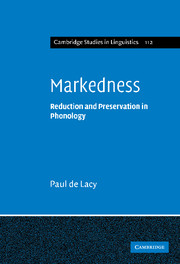Book contents
- Frontmatter
- Contents
- Preface
- Acknowledgments
- Symbols and abbreviations
- 1 What is markedness?
- 2 Theory
- 3 Markedness reduction
- 4 Preservation of the Marked
- 5 Conflation in reduction
- 6 Markedness conflation in preservation
- 7 Markedness conflict: vowels
- 8 Predictions and alternatives
- 9 Conclusions
- References
- Subject index
- Language index
Preface
Published online by Cambridge University Press: 22 September 2009
- Frontmatter
- Contents
- Preface
- Acknowledgments
- Symbols and abbreviations
- 1 What is markedness?
- 2 Theory
- 3 Markedness reduction
- 4 Preservation of the Marked
- 5 Conflation in reduction
- 6 Markedness conflation in preservation
- 7 Markedness conflict: vowels
- 8 Predictions and alternatives
- 9 Conclusions
- References
- Subject index
- Language index
Summary
This book presents a new theory of markedness, a concept that is central to understanding human language. The domain of discussion is phonology (the mental representation and computation of speech sounds), but the theory applies to syntax and morphology as well.
Many linguistic phenomena show a bias towards certain segments or structures. For example, consonants are often inserted to meet prosodic requirements. Such epenthetic consonants always have coronal or glottal place of articulation (e.g. [t ʔ h] and so on); they are never dorsal (e.g. [k ɡ x ŋ]) or labial (e.g. [p b m]). Other phenomena like neutralization also produce glottals and coronals, but never labials and dorsals. To explain this consistent bias there is often an appeal to a concept of ‘markedness’: dorsals and labials are designated as ‘marked’, glottals and coronals are ‘unmarked’, and phonological processes can only ever turn marked segments and structures into unmarked ones.
Three leading ideas about markedness are presented in this book. One is that the term ‘markedness’ has often been used to refer to very different phenomena. This book is about the human Language Faculty, so a major aim is to distinguish markedness as it relates to grammatical Competence from other uses of the term.
Another central proposal is that there is pressure to preserve marked elements. This principle of ‘Preservation of the Marked’ (PoM) can prevent highly marked elements from being eliminated in phonological phenomena like neutralization and assimilation.
- Type
- Chapter
- Information
- MarkednessReduction and Preservation in Phonology, pp. xi - xivPublisher: Cambridge University PressPrint publication year: 2006

